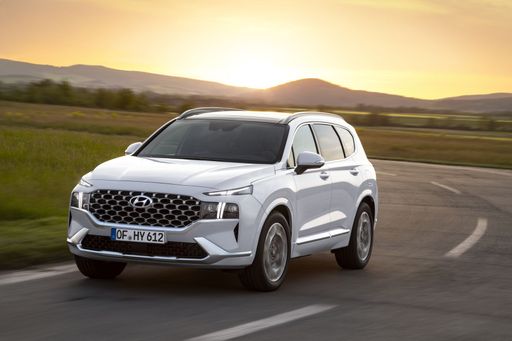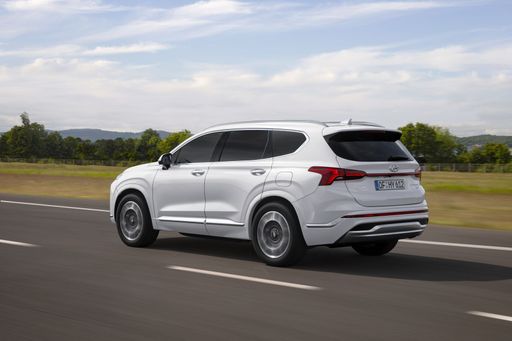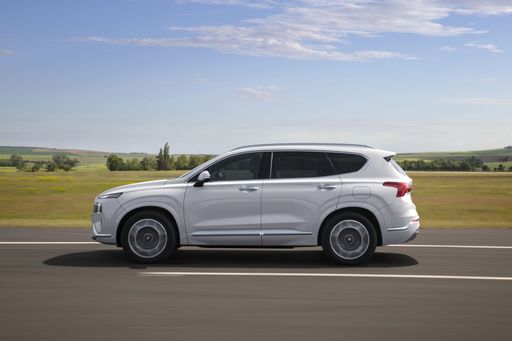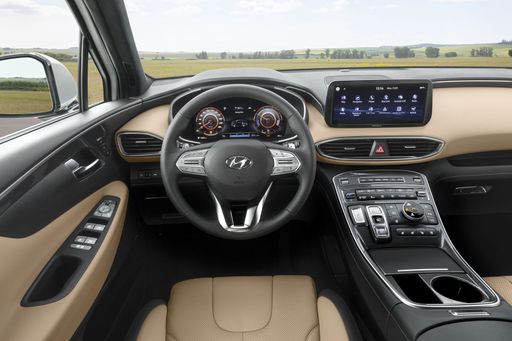Hyundai Santa Fe vs Kia EV5 – Differences & prices compared
Two cars, one duel: Hyundai Santa Fe meets Kia EV5.
Which one wins in performance, efficiency and value for money? Find out now!
Costs and Efficiency: Price and efficiency are often the first things buyers look at. Here it becomes clear which model has the long-term edge – whether at the pump, the plug, or in purchase price.
Kia EV5 has a distinct advantage in terms of price – it starts at 39400 £, while the Hyundai Santa Fe costs 51200 £. That’s a price difference of around 11794 £.
As for range, the Kia EV5 performs significantly better – achieving up to 530 km, about 476 km more than the Hyundai Santa Fe.
Engine and Performance: Power, torque and acceleration say a lot about how a car feels on the road. This is where you see which model delivers more driving dynamics.
When it comes to engine power, the Hyundai Santa Fe has a somewhat edge – offering 253 HP compared to 218 HP. That’s roughly 35 HP more horsepower.
In acceleration from 0 to 100 km/h, the Kia EV5 is slight quicker – completing the sprint in 8.40 s, while the Hyundai Santa Fe takes 9 s. That’s about 0.60 s faster.
In terms of top speed, the Hyundai Santa Fe performs somewhat better – reaching 196 km/h, while the Kia EV5 tops out at 165 km/h. The difference is around 31 km/h.
There’s also a difference in torque: Hyundai Santa Fe pulls evident stronger with 380 Nm compared to 295 Nm. That’s about 85 Nm difference.
Space and Everyday Use: Beyond pure performance, interior space and usability matter most in daily life. This is where you see which car is more practical and versatile.
Seats: Hyundai Santa Fe offers evident more seating capacity – 7 vs 5.
In curb weight, Hyundai Santa Fe is minimal lighter – 1920 kg compared to 2069 kg. The difference is around 149 kg.
In terms of boot space, the Hyundai Santa Fe offers clearly perceptible more room – 711 L compared to 566 L. That’s a difference of about 145 L.
In maximum load capacity, the Hyundai Santa Fe performs somewhat better – up to 2032 L, which is about 382 L more than the Kia EV5.
When it comes to payload, Hyundai Santa Fe clearly perceptible takes the win – 665 kg compared to 511 kg. That’s a difference of about 154 kg.
Who comes out on top?
Overall, the Hyundai Santa Fe shows itself to be shows small but notable strengths and secures the title of DriveDuel Champion.
It convinces with the more balanced overall package and proves to be the more versatile choice for everyday use.

Hyundai Santa Fe
Hyundai Santa Fe
The Hyundai Santa Fe offers a refined blend of style and functionality, making it a strong contender in the SUV market. Its modern interior, combined with advanced technology and comfort features, creates an inviting and practical driving environment. With its sleek design and robust performance, the Santa Fe is well-suited for both urban commutes and family adventures.
details @ hyundai.news
@ hyundai.news
 @ hyundai.news
@ hyundai.news
 @ hyundai.news
@ hyundai.news
 @ hyundai.news
@ hyundai.news
 @ hyundai.news
@ hyundai.news
Kia EV5
Kia's EV5 is an exciting entry into the electric SUV market, showcasing the brand's commitment to sustainable mobility. With its modern design and advanced technology features, the EV5 promises to deliver a smooth and environmentally friendly driving experience. The interior offers a spacious and comfortable ride, making it an appealing choice for families and eco-conscious drivers alike.
details

|
|
|
|
|
Costs and Consumption |
|
|---|---|
|
Price
51200 - 58400 £
|
Price
39400 - 45400 £
|
|
Consumption L/100km
1.7 - 7.1 L
|
Consumption L/100km
-
|
|
Consumption kWh/100km
-
|
Consumption kWh/100km
16.9 - 17.8 kWh
|
|
Electric Range
54 km
|
Electric Range
505 - 530 km
|
|
Battery Capacity
-
|
Battery Capacity
81.40 kWh
|
|
co2
38 - 160 g/km
|
co2
0 g/km
|
|
Fuel tank capacity
47 - 67 L
|
Fuel tank capacity
-
|
Dimensions and Body |
|
|---|---|
|
Body Type
SUV
|
Body Type
SUV
|
|
Seats
5 - 7
|
Seats
5
|
|
Doors
5
|
Doors
5
|
|
Curb weight
1920 - 2165 kg
|
Curb weight
2069 kg
|
|
Trunk capacity
621 - 711 L
|
Trunk capacity
566 L
|
|
Length
4830 mm
|
Length
4610 mm
|
|
Width
1900 mm
|
Width
1875 mm
|
|
Height
1720 mm
|
Height
1675 mm
|
|
Max trunk capacity
1942 - 2032 L
|
Max trunk capacity
1650 L
|
|
Payload
560 - 665 kg
|
Payload
511 kg
|
Engine and Performance |
|
|---|---|
|
Engine Type
Plugin Hybrid, Full Hybrid
|
Engine Type
Electric
|
|
Transmission
Automatic
|
Transmission
Automatic
|
|
Transmission Detail
Automatic Gearbox
|
Transmission Detail
Reduction Gearbox
|
|
Drive Type
All-Wheel Drive, Front-Wheel Drive
|
Drive Type
Front-Wheel Drive
|
|
Power HP
239 - 253 HP
|
Power HP
218 HP
|
|
Acceleration 0-100km/h
9 - 9.3 s
|
Acceleration 0-100km/h
8.40 s
|
|
Max Speed
180 - 196 km/h
|
Max Speed
165 km/h
|
|
Torque
367 - 380 Nm
|
Torque
295 Nm
|
|
Number of Cylinders
4
|
Number of Cylinders
-
|
|
Power kW
176 - 186 kW
|
Power kW
160 kW
|
|
Engine capacity
1598 cm3
|
Engine capacity
-
|
General |
|
|---|---|
|
Model Year
2024 - 2025
|
Model Year
2025
|
|
CO2 Efficiency Class
B, E, F
|
CO2 Efficiency Class
A
|
|
Brand
Hyundai
|
Brand
Kia
|
What drivetrain options does the Hyundai Santa Fe have?
Available configurations include All-Wheel Drive or Front-Wheel Drive.
The prices and data displayed are estimates based on German list prices and may vary by country. This information is not legally binding.
